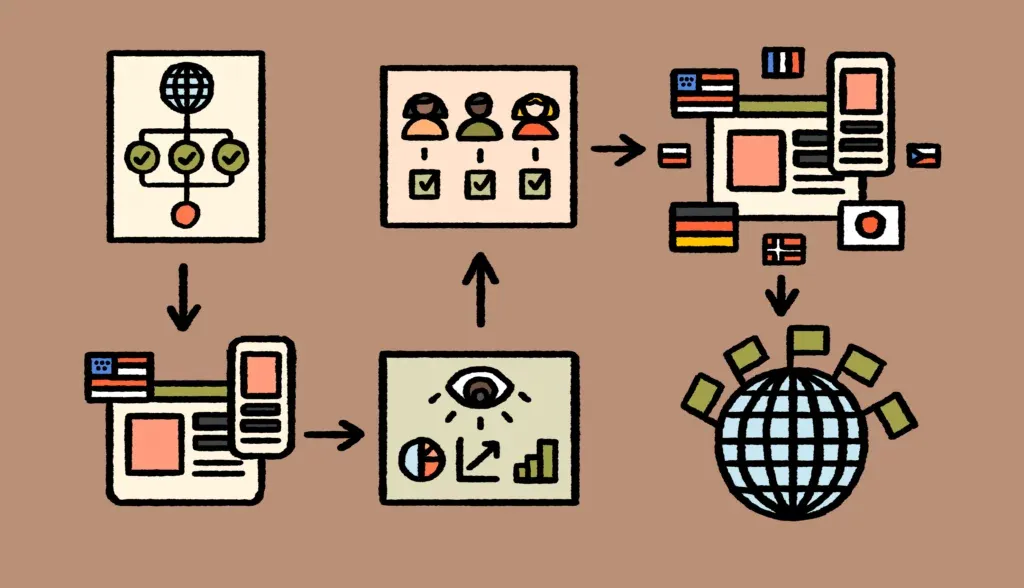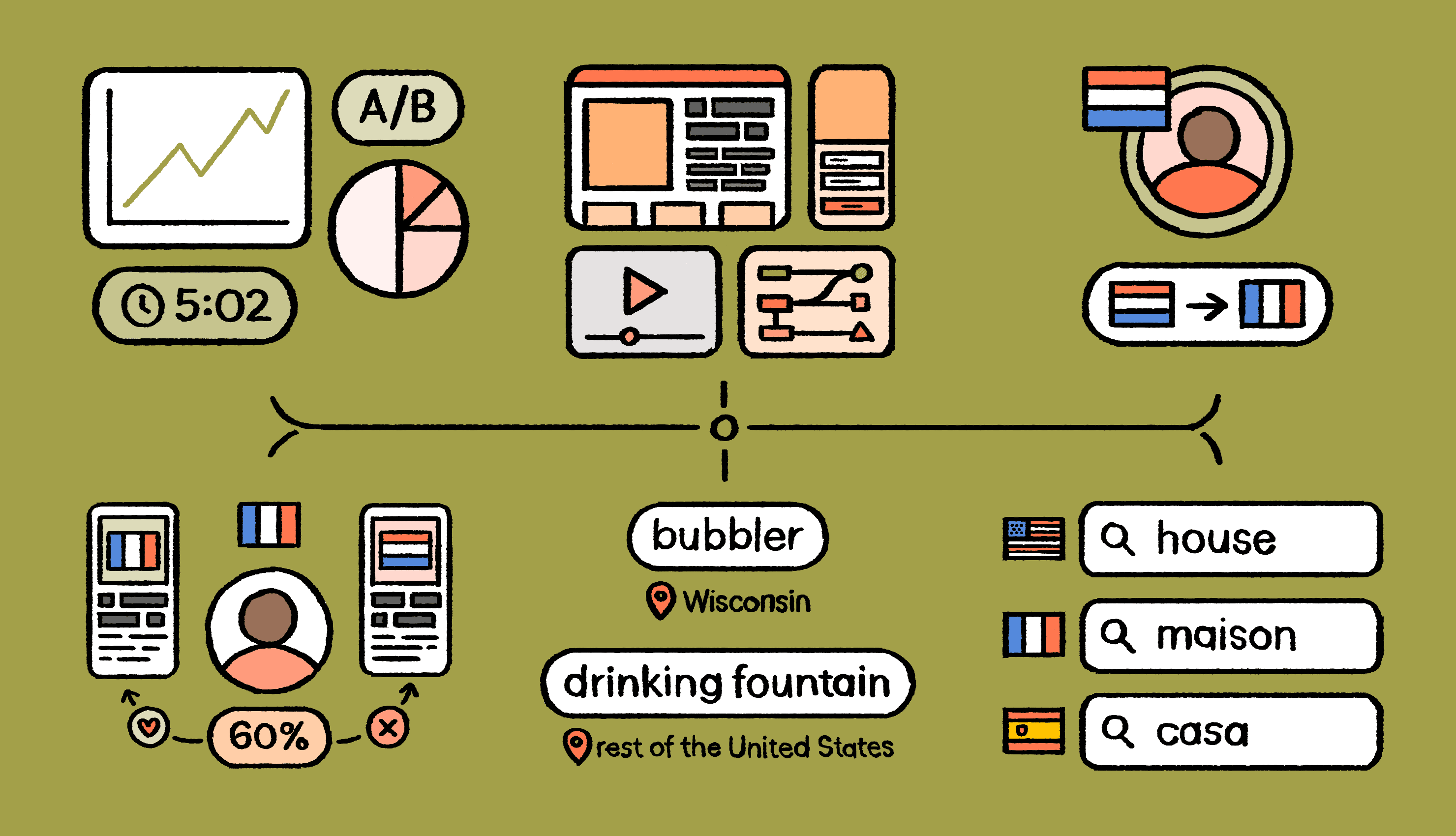Whether your product fits the market
This is the big one. You might call it the “ice cream to the Inuit” part: what are the conditions in your home market that make your product valued, and are those conditions the same in the market you’re going to? Chances are they won’t be.
If you’re selling sweet treats that keep your customers cool in a tropical summer, they might find a market in the frozen North where people are on first-name terms with penguins. But you’ll have to position your product very differently. Marketing and sales should consult with you when deciding to go after a new market to ensure you’re ready to go into that market and go through a checklist of product market fit.Customer experience, design, support – should all understand what it takes to go into a new market, and they will need your expertise to achieve their goals. The goal is to create a product or a service that is ready for a given market. You will enable potential users and buyers to FIND YOU, USE YOU, and LOVE YOU. Find you through demand generation strategy, translation, local events, content marketing, and sales on the ground.
Whether your plan is scalable
A go-to-market strategy normally means more than one market. So don’t blow your entire budget on a plan that involves just one country. If you’re a success there, you’ll want to roll out to other places as soon as possible after.
Let’s say your SaaS go to market strategy is selling a ton of seats for your software in Mexico City. Does that mean you can use the same documentation and content in Guatemala? In Peru? In Chile? Yes, they share a language … but there are large regional differences in dialect.
Whether you’re being fine-grained enough
Related to the above, it’s easy to divide the world into Europes, the Americas, and EMEA while completely forgetting how different cultures are within those regions.
Remember: Vancouver and Tierra del Fuego are both in the Americas. The Norwegian fjords and the hills of Tuscany are both in Europe. And try telling an Indian and a Chinese that they’re the same market. (Or even two Indians or Chinese from different regions.)
How many adaptations and variants you need
Another area where go-to-marketers fall down is underestimating just how different local tastes are, and how many variants it takes to cover even one global region. From cars to software, products differ in substance and detail for audiences in different places.
And we’re not talking about national borders. What sells in Texas may not go down well in California. And if you’ve ever been to both New York and Kansas … you get the idea. Count up just how many lines your core product may need to fork into.
How to build a go to market strategy
Obviously a GTM strategy framework is different for each market offering – that’s the whole point. But most plans divide into three clear phases. Let’s look at all three.
Phase 1: Research
1. Define your target audience
Look around the world, and you’ll see surprising variance in what kind of people, buy what, where. Educational software for school-age kids in Singapore may find an audience among retired men in Taiwan; technology that appeals to adult women in Los Angeles may set expectations for teens in Wisconsin. It’s all about who finds your product or service most useful … and what your brand aspirations are.
You probably already have an idea of your ideal customer. So use that as a base, and for each market, work out your “Buyer Personas” – fleshed-out portraits of people in your audience with a good chance of buying from you. Then see how close those personas are to your ideal customer and note the differences. That’s a great basis for seeing how customized your offer to that market will need to be.
2. Measure demand in your target markets
How big is your market in each territory your GTM plan lists? Singapore is a tiny country … but a large market. While Sub-saharan Africa covers a vast area with pockets of wealth.
So look for products like yours across in markets across your global plan, and see how they’re selling. This may be a big job, taking in both global names and local niche brands – but it’s absolutely necessary. While you may not have many direct competitors, you’ll certainly have some “adjacent” ones who appeal to the same customer demographics and psychographics.
And remember there’s a shortcut. What are your top search phrases and keywords, the ways people reach you on Google? Looking at search volumes in the markets you’re approaching can give many clues to the demand there. Just don’t rely on it to the exclusion of everything else. If you want a framework on measuring the opportunity, you’ll find one at our blog on market expansion.
3. Understand the competition
Next, look more deeply at those competitors. Perhaps their products and services are much the same as yours – but what position do they hold in the customer’s mind?
This is the opportunity for many challenger brands moving into a new market. Your competition may be strong, with excellent products and devoted customers. But if the headspace they occupy is for low cost, there may be a gap for a premium brand. If they’re mass market, there are opportunities in going niche.
The classic book on this stuff is Jack Trout’s “Positioning: the battle for your mind”, as fresh today as when written in the 1980s. Read it and give yourself and advantage the average 20something in a marketing department doesn’t have.
4. Create a value matrix
Diagrams are always useful when making sense of complex data – so draw yourself a few. A value matrix plots what you offer against your competitors.
Start with a sheet of paper (or equivalent online) and divide it into four boxes with an x and y axes down and across. Decide the four most important attributes of your competitive sector (for example: price, availability, ease of use, snob appeal) and label the boxes with them. Next, put an X where you think each of your competitors sits, further from the center the more it applies. (For example, those who compete on price and nothing else are at the far corner of your “price” box.) Then do one for yourself.
This will give you a rough idea of where you’re best able to compete, which will inform your marketing and sales plans later. And yes, you may have to do one for each market.
5. Decide your pricing strategy
The value matrix will also help decide your pricing within each market. It’s not as easy as pile-’em-high-and-sell’em-cheap if you’re the value choice. You’ll also need to look at size of market and profit margins, which affect your ability to invest.
Your product may be perfect for the Hmong people of Northern Thailand, but full localization will simply cost too much. So you may decide you can’t enter that market … yet. And that’s fine. You’ve saved money.
6. Outline your marketing channels and spend
While marketing channels are a bit simpler these days – it’s search strategy, social media, and the few big websites that matter, it’s still important to work out which sites and stations you’ll put on your marketing plan, and how much they’ll cost. If you’re pursuing a multi-domestic strategy, these decisions may vary significantly by country or region. You don’t need a full media plan at this point; just make some informed decisions about what it’s likely to cost to reach, persuade, and convert a single customer, ranged against how many customers make up a successful outcome.
Again, Google and its partners can be your friend. There are tools that can predict in great detail how much your clicks and views will cost, enabling you to put together an accurate budget in advance of a full marketing translation campaign. Use them.
Phase 2: Craft your action plan
Phase 1 was mostly research; Phase 2 is about getting ready for action – choosing the concrete steps you’ll take to achieve your go-to-market goals. Let’s continue with them.
1. Create your launch plan
This part you’ll find familiar: a go-to-market action plan, stating clearly what will happen when and who’s responsible. But go-to-market strategies involving multiple countries are more complex than those in one market – so it’s worth keeping everything smooth by deciding how you’ll manage each in-market project.
Take a critical look at your localization partners (those doing your translations, transliterations, and interpretations across both language and culture) and whether they offer the right connections to your project management applications. It’ll make life much easier later.
2. Craft your messaging
This is where your go-to-market strategy starts morphing into your marketing plan. Start with the brand attributes you’re already using – your value propositions, customer messaging, tone of voice and emotional hooks – and make sure your localization effort includes reimagining them for each new market, not just translating the words.
(Just to blow our own trumpet a moment: working with Lokalise makes this easy. A complete end-to-end platform for localization of all your content, copy, and page designs, connected to a huge audience of professional translators or available to your own. You’ll soon find out how easy it can be to keep your messaging smooth and consistent everywhere, across all languages – whether it’s on your home page or a distant campaign in a faraway city.
3. And don’t get sidetracked by one market!
Some markets are easier to plan for than others. But if you do this, it’s what management consultants Renée Mauborgne and W. Chan Kim called a “red ocean strategy” – you’re swimming where your competitors already are. Giving equal attention to a “blue ocean strategy”, an untapped market, may offer greater potential.
That’s the point of an effective go-to-market strategy framework: you’re allowing for all opportunities, even if some are further off than others.
Phase 3: Go to market!
Our final phase is where the rubber hits the road – without smoking and screeching. It’s time for your go-to-market strategy to … go to market!
1. Launch your localized products and services
This is it: the big moment. Offering your localized site and products to actual consumers in the market you’re approaching. The only thing to remember here is that success is rarely immediate: you’re here for the long term, so follow your plan. Unless, of course, it’s really not working.
2. Measure, test, learn – and roll in your learnings
And that’s why Phase 3 never ends. The watchphrase here is continuous improvement: constantly checking the performance of your localized content against your KPIs and seeing where it could get better. This isn’t about correcting “failure” – it’s about changing course based on information received. Something any global business does, every day.
A successful example: Plum’s go to market strategy
Let’s finish with a success story. Mobile money assistant app Plum worked with Lokalise to roll out into several new markets, translating content in each one. What impressed us about the company’s GTM approach was the way all departments had a voice.
At Plum, GTM strategy is led by the cross-company leadership group and every department has an equal say. The Product group makes sure new features and functionality are right for the new audience being approached; Engineering has the role of confirming everything works as advertised and is safely out of beta. While Marketing delves deeply into customer needs as time goes on and feeds back improvement suggestions to the technical team, informed by people at the coalface: those in Customer Support.
Plum’s approach makes sure all relevant information is listened to, captured, and used for ongoing improvements – with each new feature being appropriately localized on the right timescale.
So that’s your go-to-market strategy template. Feel free to adopt it, adapt it, extend it however you want – it’s your success we’re interested in.
And when you’re ready to move, why not talk to us at Lokalise? We’d love to be part of your go-to-market journey.
FAQs
1. What is a go to market team?
Your go-to-market team is a diverse group of professionals drawn from multiple areas of your business, with the goal of creating a plan that maximizes your potential for success in every market you’re moving into.
Check out our localization course for marketers with Antoine Rey, SVP Customer Development at Argos Multilingual, who has over 25 years experience working with successful international technology organizations.
In the course he reveals some of the insights and examples he has collected, including the most successful and common frameworks for localization and how to position it as a growth strategy.





